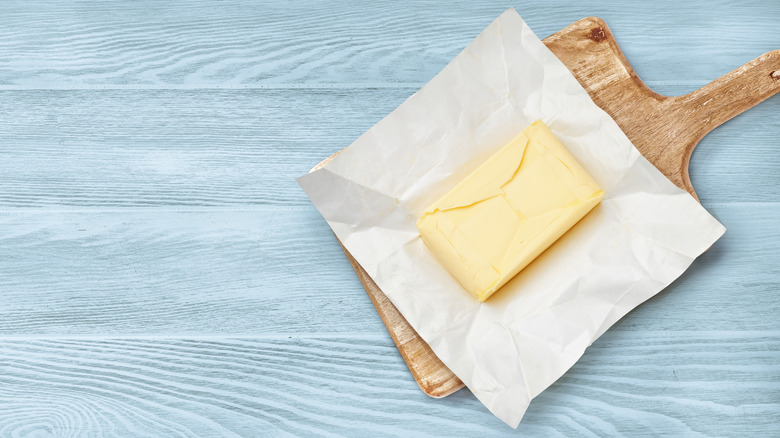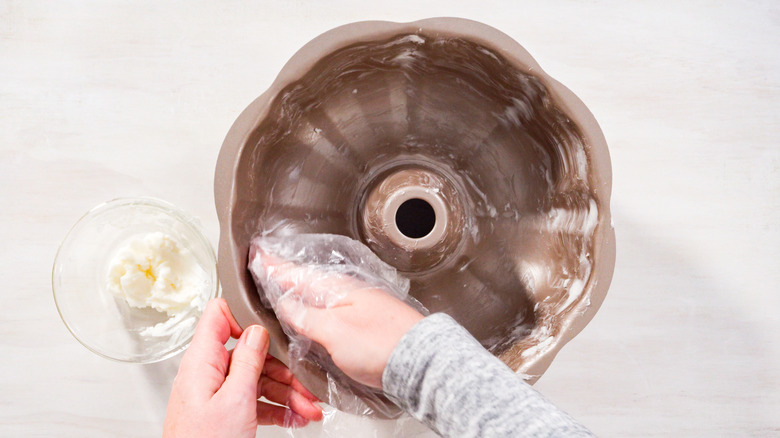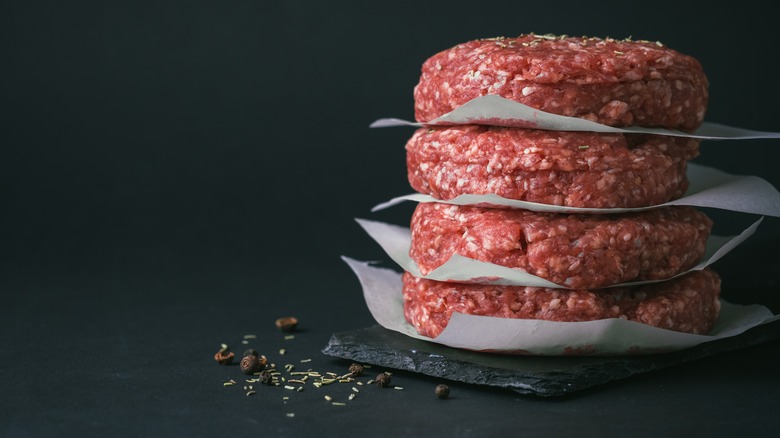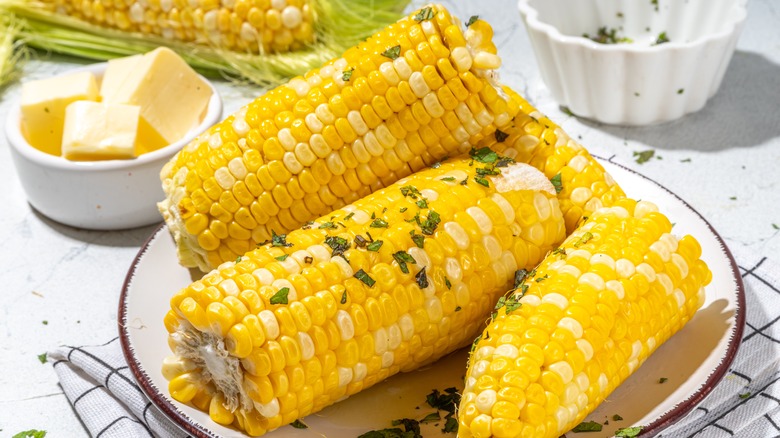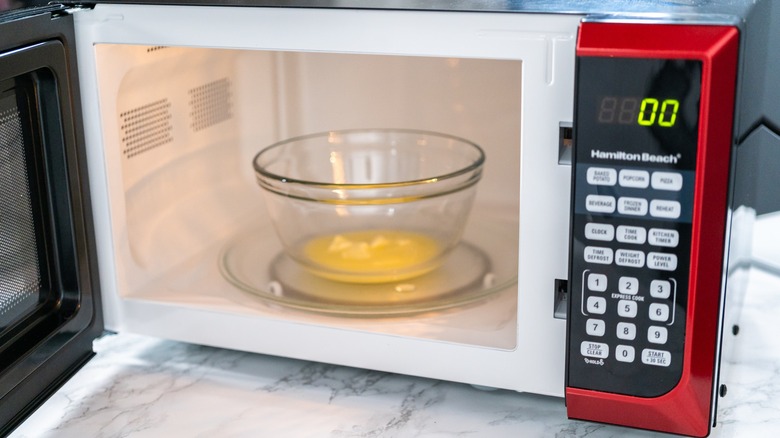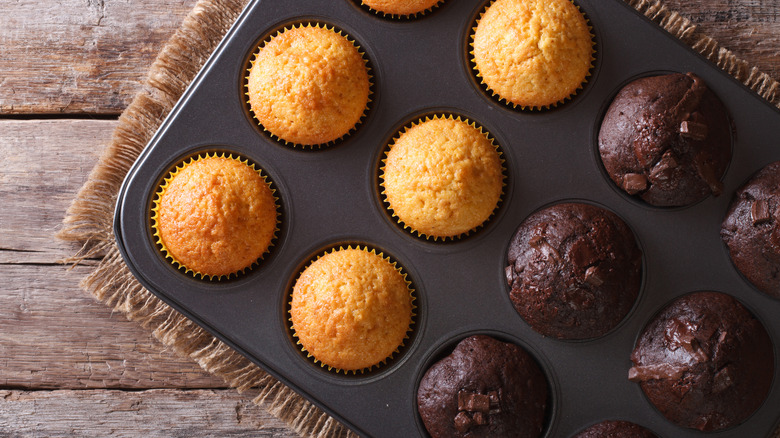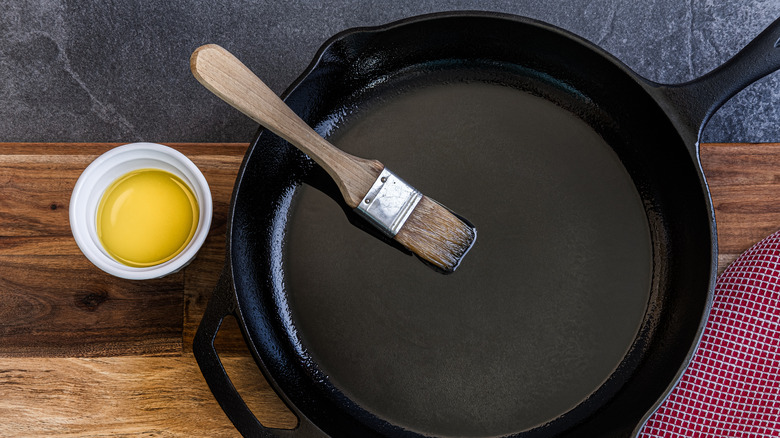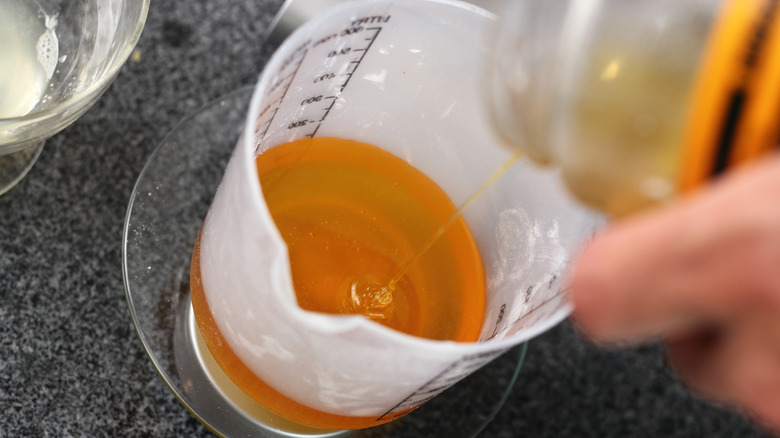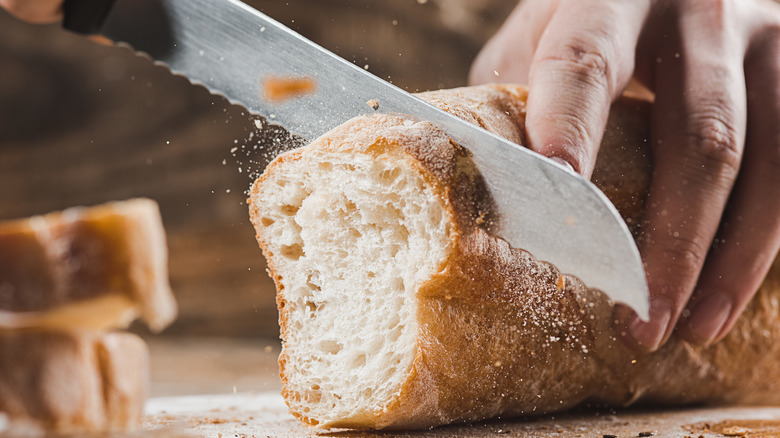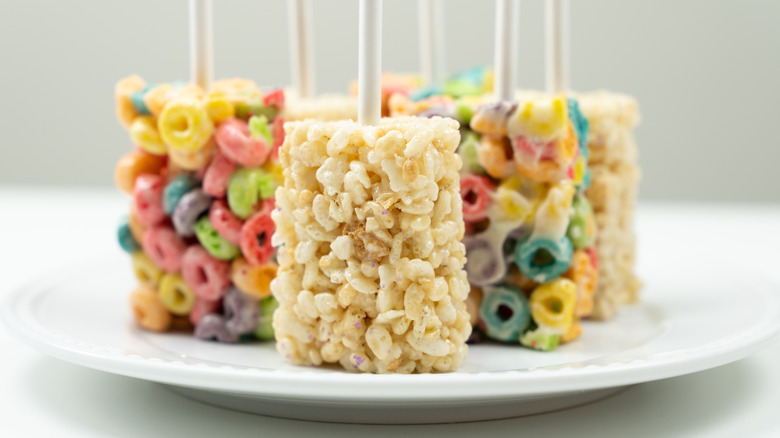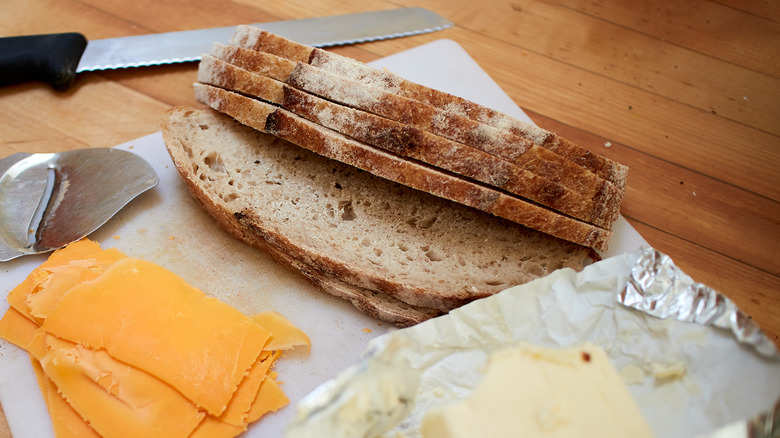10 Uses For Leftover Butter Wrappers Around The Kitchen
Most people toss their butter wrappers straight into the trash. After all, they are just packaging, right? Wrong. These small greasy pieces of paper or foil can actually be repurposed to help you accomplish a collection of other cooking tasks with minimal effort.
Essentially, butter wrappers are like parchment paper, but with the added benefit of a thin layer of grease. When you think of them this way, you can do quite a few things with them. Anything from seasoning cast iron pans to creating a layer of separation between foods to quickly slicing through fragile baked goods is possible. Plus, if you don't need a leftover butter wrapper immediately, you can easily store it in an airtight container or baggie in the fridge until it's needed.
To find the best uses for leftover butter wrappers around the kitchen, I scoured cooking blogs, recipes, home cook recommendations, and more. What I discovered will change the way you look at the next butter packaging you unwrap. Whether you are looking to save some money, make cooking tasks easier, or be more sustainable in your kitchen, reusing your butter wrappers could help you move the needle in the right direction. In fact, once you learn how versatile and handy leftover butter wrappers are, they just might be your new obsession.
Grease cookware
Leftover butter wrappers are the perfect tool for greasing cookware. They have just enough butter residue to grease up the bottom and sides of a pan. Not only does this hack enable you to use every last drop of butter, but the paper or foil wrapper also functions as a simple application tool. Simply place it face down on a pan, rub it around until the entire surface has a thin layer of butter, and it's all set for whatever you want to cook.
Butter wrappers are ideal for greasing baking pans, particularly for cakes and other baked goods that stick easily. Thanks to the hands-on process, they allow you to get into all the nooks and crannies with ease. If you've ever had a cake stick to certain parts of a Bundt pan, you know how challenging complete coverage can be. Cooking sprays are pretty helpful, but it's easy to over-grease a pan with them. Placing your hand inside a greased glove or bag is another option, but why make extra trash? Another reason butter wrappers are great for baking is that most recipes call for a fair amount of butter, so it's likely you'll unwrap a new stick.
If you are not much of a baker, you can also use your leftover butter wrappers to lightly grease frying pans. They are great for reheating food on the stove (because it doesn't typically require a lot of oil) or if you are aiming for a healthier pan-fry.
Prevent frozen and fresh foods from sticking together
Butter wrappers can be used much the same way as parchment paper. More specifically, leftover butter wrappers are perfect for keeping pre-formed foods separate, either in the fridge or freezer (just like parchment paper). They obviously have a bit of butter residue, which regular parchment paper does not, but it's not enough to mess up most ingredients or recipes. In fact, the opposite is true for many applications. For example, the thin film of butter on a wrapper makes it perform better than parchment paper if you are placing it between cookies or Rice Krispie Treats. The minimal amount of butter tastes delicious on the exterior and it makes pulling apart the layers beyond easy.
The same can be said for burger patties or sandwiches. Best of all, once you stack burgers or other treats with a butter wrapper in between, they can easily be frozen for use at a later date or transported to another location. When you are ready to cook or enjoy your layered foods, you don't have to worry about them breaking apart when you try to separate them, even if they are still frozen.
Lightly butter corn on the cob or toast
As you know, there isn't an excessive amount of butter left on the wrapper after you open a new stick or block. Still, there is enough to lightly butter a few things, like toast or corn on the cob. You could try scraping the leftover butter off of the wrapper with a silicone spatula and then spreading it on your food, but why bother when it's significantly easier to just rub the wrapper directly on the food? You can spread the butter onto a slice of toast with the paper or wrap it around a piece of corn on the cob and move it around to achieve excellent coverage.
This leftover butter wrapper hack is excellent if you are attempting to minimize the amount of butter you consume or are aiming for a healthier meal overall. It severely limits the amount of butter you can put on foods unless, of course, you reach for another slice. However, if you think of it as a pre-portioned amount, it is a fantastic way to limit yourself. One leftover butter wrapper should have enough grease on it to lightly butter a single piece of corn on the cob or one to two pieces of toast.
Cover foods in the fridge or microwave
When you put food in the fridge it needs to be covered, and for small items, butter wrappers make the perfect lid. You can place them over the top of small dishes and push the edges down to keep air out. The leftover butter on the foil or paper will help it stick and stay in place. You can also mold a butter wrapper around a ball of dough before placing it in the fridge to help lock moisture in. The same goes for microwaving foods, but instead of the makeshift lid helping keep foods fresh, it prevents unwanted splatters. Nobody likes cleaning a baked-on mess off the walls and roof of a microwave, and when used correctly, butter wrappers help ensure you don't have to.
Covering foods works best with a leftover butter wrapper made from foil because you can press down around the edges of foods and dishes to create a better, more secure seal. Paper wrappers work too, but they aren't as easily molded as foil. The only time a foil wrapper should be avoided is if you are microwaving the covered food item. Putting foil in the microwave is a surefire recipe for disaster. Even if it doesn't break the appliance entirely, it can lead to sparks and maybe even a small fire. Obviously, a butter wrapper isn't the same as a piece of aluminum foil, but I don't recommend risking it with the aluminum.
Infuse warm baked goods with buttery goodness
A little bit of extra butter tastes yummy on all different kinds of foods, and that's the idea behind this use for leftover wrappers. While not necessary, you can squeeze every last drop of butter off a wrapper by placing it over warm baked goods. Most bread, cookies, pie crusts, and muffin recipes only get better with a slight touch of butter melted over the top, and butter wrappers make executing this extra touch quick and easy.
All you have to do is place a leftover butter wrapper over the top of a pie or baking tray when it comes out of the oven. Leave it to rest for a few minutes and the job is done. Thanks to the warmth of the freshly baked goods, simply putting the wrappers on top of them allows the butter to transfer to your creations. While there are lots of tips you can use to make better muffins, this may be one of the best. It is a quick addition that can be executed right at the end, and it infuses them with yummy flavor and moisture, two things every muffin benefits from.
Season your cast iron pans
Seasoning cast iron pans is the best way to keep them in top shape. A properly seasoned pan has less chance of rusting and makes the surface easier to cook on without food sticking. The key to properly seasoning a cast iron pan is rubbing a neutral oil into the material on a somewhat regular basis, and guess what? Butter, or bet yet, butter wrappers are perfect for this task. They have enough leftover butter to add additional seasoning and they already come in an applicable form. There's no need to rub oil on a paper towel. Instead, you get to repurpose what could have easily become waste. Not in your kitchen, though.
Seasoning a pan is super simple when you use a leftover butter wrapper. After you clean your cast iron pan, dry it off immediately. Then, place a paper or foil butter wrapper on the cooking surface with the greasy side down. Slowly rub it in small circular motions until you cover the entire pan's interior. Press down enough to transfer the butter but not so hard that it rips the paper. You also want to frequently change the position of your fingers on the wrapper so that you get all the good stuff off the paper and onto the pan.
Grease measuring cups for sticky ingredients
Measuring sticky ingredients like honey and maple syrup can be tricky. Due to their tacky nature, they coat the inside of measuring cups and spoons, so they don't really pour out the way you want. As a result, getting a precise measurement and cleanup can be fairly challenging. You can always use a spatula to scrape out what's left behind, but there's an even easier hack; greasing your measuring utensils in advance with a leftover butter wrapper. While most of us probably haven't thought of this before, it almost seems like it should be common sense. Just like with a baking pan, greasing measuring cups and spoons prevents ingredients from sticking to them.
One of Martha Stewart's best hacks for aspiring home chefs is to lightly coat measuring utensils with olive oil for simpler use, and butter wrappers are a great substitute. If this tip is good enough for Martha Stewart, it's definitely good enough for us. When you use a butter wrapper there's an added bonus: It's virtually impossible to apply too much. If you add too much oil, it can pool in the bottom of the measuring cup and potentially alter your recipe. With a leftover butter wrapper, this shouldn't happen because there isn't much butter to begin with.
Easily slice through baked goods and sticky foods
Greasing knives before slicing through soft baked goods and sticky foods is another outstanding way to use your leftover butter wrappers. It makes it easier to cut them into smaller pieces and also leads to quicker cleanup. Fluffy, flaky pastries like croissants easily break up and fall apart when you cut through them. However, if you rub the inside of a leftover butter wrapper on the knife first, it effortlessly slices through the pastry without destroying its structure in the process. Soft cakes are also less likely to crumble when sliced with a slightly buttered knife. A little extra butter doesn't hurt the flavor of the cake, either.
Sticky candies and baked goods like toffee, caramels, and cinnamon rolls are also easier to cut with a knife greased by a leftover butter wrapper. Of course, the knife is also easier to clean. Instead of struggling to get stuck on sugar off the blade, you should be able to simply wipe all the sticky residue off and wash it like normal. Whatever you decide to slice, use extreme caution when greasing a knife. Fold the leftover butter wrapper over the blade, so it's completely covered on both sides. Then, move the wrapper up and down slowly, making sure to keep your fingers far away from the sharp side of the blade. Pay attention and don't move too fast. Otherwise, you could quickly cut yourself.
Form Rice Krispy Treats without the mess
Rice Krispie Treats are a beloved American dessert. They transform a popular cereal into a deliciously sweet treat and they are incredibly easy to make. The trickiest, or the messiest, part of the entire process is pushing and molding the mix into a pan. If you don't do it right, your Rice Krispie Treats turn out lumpy and inconsistent.
All things considered, molding Rice Krispie treats isn't super difficult, but it's definitely messy. Typically, you wind up with melted marshmallows and butter all over your hands, but there's a quick fix: Use a leftover butter wrapper to press down and mold the mix. Whether you are making the traditional square-shaped Treats cut from a shallow pan or are molding them into unique shapes, butter wrappers are the perfect tool to keep your hands clean.
Using a butter wrapper to mold Rice Krispie Treats ensures all the mess stays off of your hands. It also adds a touch more butter than the recipe calls for, which has the potential to add more moisture. Of course, if you want to banish dry Rice Krispie Treats forever, we recommend adding sweetened condensed milk. It'll keep them significantly softer for much longer than butter alone.
Keep bread slices soft or separate
Saving your butter wrappers to keep sandwich bread soft is another pro move. The crust on a loaf of bread does a great job of keeping moisture locked inside, but once it is cut or the heel is removed it exposes the doughy interior to air which dries it out. If left cut and exposed to air for very long, bread quickly becomes dry and goes stale. However, leftover butter wrappers can be used to slow this process down.
Fresh homemade bread in particular dries out rather quickly once the end is sliced off. When you place a butter wrapper on top of the exposed end, it helps trap moisture inside and extends the loaf's potential lifespan. It also adds a touch of butter, increasing flavor. If you prefer slicing the entire loaf at once, you can also place a butter wrapper between each slice to prevent sticking and help keep them fresher for longer. Of course, you'll need quite a few leftover butter wrappers, but if you've been stockpiling them in a baggie in the fridge for a while, this is their time to shine.
Store-bought pre-sliced loaves of bread typically have preservatives in them. They come in a plastic bag, too. As a result, they won't dry out nearly as quickly as a freshly baked loaf. Still, this handy butter wrapper trick can be beneficial. It certainly won't diminish quality, so what do you have to lose?

